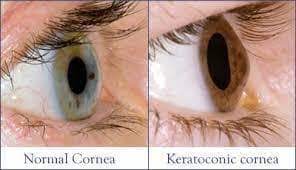Do you have a thin cornea? If so, you may be a good candidate for Thin Cornea LASIK. Thin Cornea LASIK is a new surgical procedure that can correct vision in people with thin corneas. This procedure is different from traditional LASIK surgery, which is not recommended for people with thin corneas. In this blog post, we will discuss the benefits of Thin Cornea LASIK and how to determine if you are a good candidate for this procedure.
Contents
What Is Thin Cornea Lasik?

Thin cornea LASIK is a type of refractive surgery used to correct vision. It is performed by reshaping the cornea, which is the clear, round surface at the front of the eye.
LASIK surgery has become increasingly popular in recent years, as it can improve vision without the need for glasses or contact lenses.
The surgery is most commonly used to correct nearsightedness, farsightedness, and astigmatism.
Can You Fix Thin Cornea With Lasik?

The LASIK procedure is not safe for people with thin corneas. This is because, during the surgery, a portion of your cornea must be removed, and if there isn’t enough tissue, to begin with, it could cause vision problems.
If you have a thin cornea, there are other options for vision correction, such as PRK or implantable contact lenses. PRK is very similar to LASIK, but instead of using a laser to create the flap in your cornea, the surgeon will use a blade. This means that no tissue needs to be removed, so it’s a safer option for people with thin corneas.
If you have thin corneas and farsightedness, lens replacement surgery may be the best option for you. This procedure replaces your eye’s natural lens with an artificial intraocular lens, which results in sharper vision. In some cases, patients no longer need reading glasses after the surgery.
Who Isn’t Suitable For Lasik?
The Lasik is not suitable for everyone. These reasons are:
- Your vision has changed too much in the past year.
- A thin cornea is not suitable for Lasik.
- You have a severe form of nearsightedness, farsightedness, or astigmatism.
- You have certain eye conditions, such as glaucoma, cataracts, or diabetic retinopathy.
- You have dry eyes.
- You are pregnant or breastfeeding.
- You are younger than 18 years old or older than 65 years old.
- You have had a previous eye injury or surgery.
- You have been diagnosed with an autoimmune disease.
If you are not sure if Lasik is right for you, please consult your eye doctor.
Is There Any Alternative To Lasik Eye Surgery?

There are various alternatives for thin cornea:
Photorefractive keratectomy (PRK)
PRK is a type of refractive surgery that uses a laser to correct vision. It is similar to LASIK, but instead of creating a flap in the cornea, the outer layer of the cornea (the epithelium) is removed. This makes PRK more suitable for people with thin corneas or other conditions that make LASIK unsafe.
PRK can be performed on an outpatient basis and usually takes about 30 minutes. Recovery time is usually shorter than with LASIK, but vision may be blurry for the first few days and complete recovery can take up to a month.
Laser-assisted subepithelial keratectomy (LASEK)
LASEK is another type of refractive surgery that uses a laser to correct vision. It is similar to PRK, but instead of removing the entire outer layer of the cornea, only a part of it is removed. This makes LASEK less invasive than PRK and helps speed up the healing process.
Conductive keratoplasty (CK)
CK is a type of refractive surgery that uses radiofrequency waves to correct vision. It is less invasive than other types of refractive surgery and can be performed on an outpatient basis.
CK usually takes about 15 minutes and recovery time is typically shorter than with other types of refractive surgery. However, vision may be blurry for the first few days and complete recovery can take up to two weeks.
Intraocular lens implants (IOLs)
IOLs are a type of refractive surgery that involves implanting a plastic lens inside the eye. IOLs can be used to correct a wide range of vision problems, including nearsightedness, farsightedness, and astigmatism.
IOL surgery is usually performed on an outpatient basis and takes about 30 minutes. Recovery time is typically shorter than with other types of refractive surgery, but vision may be blurry for the first few days and complete recovery can take up to two weeks.
SMILE
The minimally invasive alternative to LASIK. If you’re not a fan of needles, lasers, or having your eyes held open for long periods of time, then SMILE might be the vision correction surgery for you. SMILE, which stands for small incision lenticule extraction, is a newer type of refractive surgery that uses a femtosecond laser to correct myopia (nearsightedness), hyperopia (farsightedness), and astigmatism. The entire surgery is performed through a small incision in the eye that is only 2-4 mm in size, which is about one-third the size of the incision used in LASIK surgery. This smaller incision results in less trauma to the eye, which speeds up the healing process and leads to fewer side effects and complications.
SMILE is a minimally invasive alternative to LASIK that can correct myopia (nearsightedness), hyperopia (farsightedness), and astigmatism. The entire surgery is performed through a small incision in the eye that is only 2-4 mm in size, which is about one-third the size of the incision used in LASIK surgery.
Refractive Lens exchange
With this type of vision correction, the eye’s natural lens is removed and replaced with a man-made intraocular lens (IOL). The IOLs used in RLE procedures are similar to those used in cataract surgery. Depending on your specific refractive error, the surgeon will choose an IOL that will correct your distance vision, near vision or both. Multifocal and accommodating IOLs are also available and can correct presbyopia (age-related farsightedness).
Conclusion
It may be concluded that thin cornea Lasik is not suitable to correct thin cornea and improving vision. This is because it may lead to some complications like dry eye and night vision problems.
It is important to consult an experienced ophthalmologist before opting for this surgery. He/she will be able to guide you on whether you are a suitable candidate for thin cornea Lasik or not. There are various alternatives to this surgery that can be used to improve vision. Your ophthalmologist will be able to guide you on the best option for you.
For more information and guidance, please contact Eye Mantra. This platform offers the most accurate guidance and advanced surgical options for your eyes including Cornea Surgery, PRK, Femto Lasik, SMILE surgery, Standard LASIK, and Contoura vision. If you have any questions on LASIK surgery, LASIK surgery cost, and LASIK procedure, call us at +91-9711116605 or email at [email protected].


